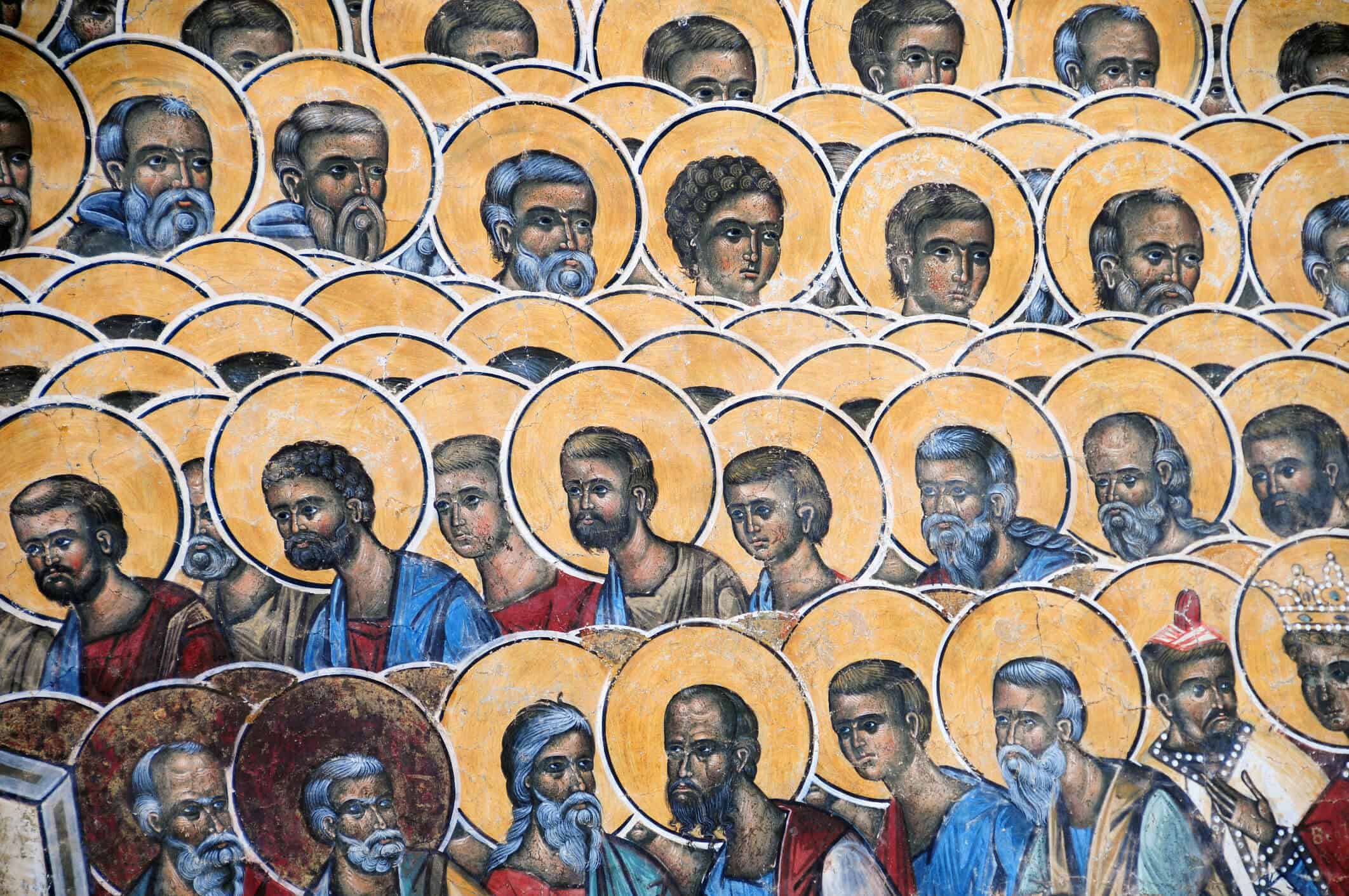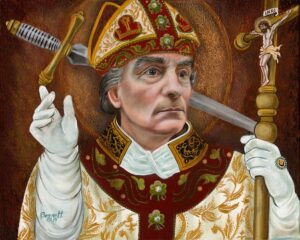December 3
St. Francis Xavier
Francis Xavier was born in the Kingdom of Navarre on April 7, 1506. Nobly born, his father was the privy counselor to King John III of Navarre. When he came of age he was sent to Paris to study philosophy at the University of Paris. where he planned to eventually become a professor.
He shared rooms with Peter Favre, and both young men became good friends with Ignatius of Loyola. worked tirelessly to have Francis recognize his vocation to the priesthood. At the age of 24, Francis made his spiritual commitment, and with Peter Favre in 1534, joined Ignatius’s little community, the infant Society of Jesus. Together at Montmartre they vowed poverty, chastity, obedience, and apostolic service according to the directions of the pope. Francis was ordained a priest in 1537 in Venice.
At that time, Portugal was actively colonizing the port city of Goa. Disturbed by the waning faith of the Portugese settlers, the King of Portugal asked the Pope to send missionaries to the region. The pope chose the Society of Jesus, and Ignatius chose Francis. On his 34th birthday, he sailed to India, knowing he would probably never again see his friends who remained behind.
For the next 10 years he labored to bring the faith to such widely scattered peoples as the Hindus, the Malayans, and the Japanese; as well as serving as provincial of the newly established Jesuit province of India. He spent much of that time in India, but also traveled to the Malaysia, Indonesia, and Japan. He baptized some 40,000 converts..
Wherever he went he would seek out and help the poor and forgotten. He traveled thousands of miles, most on his bare feet, and he saw the greater part of the Far East., Xavier lived with the poorest people, sharing their food and rough accommodations. He spent countless hours ministering to the sick and the poor, particularly to lepers. Very often he had no time to sleep or even to say his breviary but, as we know from his letters, he was filled always with joy.
Xavier went through the islands of Malaysia, where he baptized the first Japanese convert. Intrigued by the tales of Japan, he learned enough Japanese to preach to simple folk, to instruct, and to baptize, and to establish missions for those who were to follow him. From Japan he had dreams of going to China, but this plan was never realized. Before reaching the mainland, he died. His remains are enshrined in the Church of Good Jesus in Goa. He and Saint Thérèse of Lisieux were declared co-patrons of the missions in 1925.
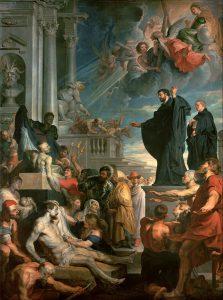
“No-one may ever excel in great things, who do not first excel in little things.”
St. Francis Xavier
December 6
St. Nicholas of Myra
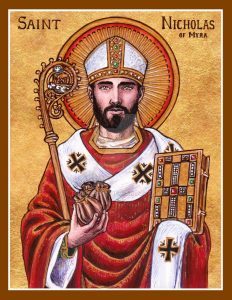
St. Nicholas was of Greek descent, born to wealthy parents in Asia Minor in the 3rd or 4th century. Both of his parents died during an epidemic when he was a young man, leaving him well off, but to be raised by his uncle – the Bishop of Patara. Obeying Jesus’ words to “sell what you own and give the money to the poor,” Nicholas used his whole inheritance to assist the needy, the sick, and the suffering. He became the bishop of Myra in Turkey and many stories attest to his generosity to the poor and hungry, especially children.
The Greek histories of his life agree he suffered an imprisonment of the faith and made a glorious confession in the latter part of the persecution raised by Diocletian, and that he was present at the Council of Nicaea and there condemned Arianism.
According to another tradition St. Nicholas was not only there during the Council of Nicaea in 325, but so far forgot himself as to give the heretic Arius a slap in the face. The conciliar fathers deprived him of his episcopal insignia and committed him to prison; but our Lord and His Mother appeared there and restored to him both his liberty and his office.
After his death, the legend of his gift-giving grew. St. Nicholas was transformed by the Dutch into the legendary character called Sint Nikolaas or by his nickname Sinterklaas. When Dutch immigrants brought his gifting traditions to this country, he eventually evolved into Santa Claus and became a part of the Christmas tradition.
“The giver of every good and perfect gift has called upon us to mimic Gods giving, by grace, through faith, and this is not of ourselves.”
– St. Nicholas of Myra
December 9
St. Juan Diego Cuautlatoatzin
December 9: Memorial of St. Juan Diego Cuautlatoatzin
Nestled between two great Marian celebrations (Immaculate Conception on December 8 and Our Lady of Guadalupe on December 12) is the optional memorial of St. Juan Diego Cuauhtlatoatzin (“the talking eagle”). He was raised in the pagan Aztec tradition from an early age. At the age of 50, he and his wife Maria Lucia were baptized by Franciscan missionaries, and became two of the first Native American converts in Mexico.
Juan Diego would walk great distances to receive religious instructions and to attend mass. In 1531, while on his way to the mass celebrating the Immaculate Conception, he saw a beautiful young woman dressed like an Aztec princess, who said she was the Virgin Mary and asked Juan to tell the bishop to build a church on that site. When the bishop pressed him for proof, Juan appealed to the woman who promised him a sign on the next day, December 11. Because his uncle took ill, he was unable to meet the woman on that day.
When he encountered her on the following day and told her of his uncle, she replied, “No estoy yo aqui que soy tu madre?” (Am I not here, I who am your mother?). She promised him his uncle would be restored to health and directed him to the top of a hill, where Juan found roses growing in the frozen December ground. He filled his tilma or cloak, and took the flowers to the bishop. When he opened his cloak, the flowers fell to the ground before the bishop, revealing an image of the lady imprinted on the tilma. With the Bishop’s permission, Juan Diego lived the rest of his life as a hermit in a small hut near the chapel where the tilma was kept in a place of honor. There he cared for the church and the first pilgrims who came to pray, until his death at the age of 74. The same tilma is still displayed in a place of honor in the Basilica of Guadalupe.
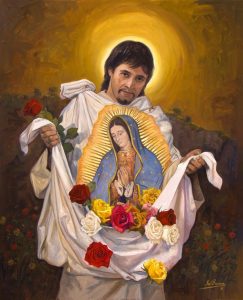
“I am a nobody, I am a small rope, a tiny ladder, the tail end, a leaf”
–St. Juan Diego
December 12
Our Lady of Guadalupe
St. Juan Diego Cuauhtlatoatzin (“the talking eagle”) was a Native American convert born in what is now a part of Mexico City. In 1531, while on his way to daily mass, he saw a beautiful young woman dressed like an Aztec princess, who said she was the Virgin Mary and asked Juan to tell the bishop to build a church on that site. When the bishop pressed him for proof, Juan appealed to the woman who directed him to the top of a hill, where Juan found roses growing in the frozen December ground. He filled his tilma or cloak and took the flowers to the bishop. When he opened his cloak, the flowers fell to the ground before the bishop, revealing an image of the lady imprinted on the tilma.
With the Bishop’s permission, Juan Diego lived the rest of his life as a hermit in a small hut near the chapel where the tilma was kept in a place of honor. There he cared for the church and the first pilgrims who came to pray. The same tilma is still displayed in a place of honor in the Basilica of Guadalupe. Despite all odds, the image of our lady is still fresh and vibrant, on a piece of rough peasant clothing which should have disintegrated hundreds of years ago.
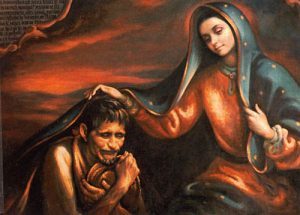
December 13
St. Lucy of Syracuse
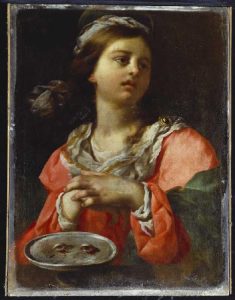
St. Lucy (283-304) was born in Syracuse, Sicily, where she was also martyred during the persecutions of Diocletian. She was of a noble Greek family, and – her father having died when she was only 5 – was brought up as a Christian by her mother. Her mother was ill with a bleeding disorder and, fearing for her daughter’s future welfare, betrothed her to a young man. Three years later, when she was miraculously cured at the shrine of St. Agatha in Catania, she acceded to Lucy’s request that she remain unmarried.
This so angered the youth to whom she had been unwillingly betrothed that he denounced her as a Christian to the governor of Sicily. When it was decided to commit her to a brothel, Lucy, with the help of the Holy Spirit, could not be physically moved by the guards, even after they hitched her to a team of oxen. The governor ordered her to be tortured and executed. After her eyes were torn out, a fire was built around her, but again God protected her and the burning bundles of wood around her went out. As she prophesied against her tormentors, she was finally stabbed in the neck with a dagger and died.
Legend has it that, before she died, her sight was restored. Lucy, whose name can mean “light” or “lucid,” is the patron saint of the blind. Pope Saint Gregory the Great, familiar with the Christian traditions of Sicily through his family, inserted the names of the Sicilian virgin martyrs, Agatha and Lucy, into the Roman Canon.
O St Lucy, preserve the light of my eyes
Anon
so that I may see the beauties of creation,
the glow of the sun,
the colour of the flowers
and the smile of children.
December 14
St. John of the Cross
St. John of the Cross was born Juan de Yepes y Alvarez, in Fontiveros, Avila, Spain in 1542. His wealthy father was disowned when he married a poor weaver’s daughter, and John grew up in grinding poverty. His father died when he was only 3, and his older brother died of malnutrition two years later.
At 14, he took a job serving the sick in a hospital of Medina, and 7 years later, became a lay brother to the Carmelite friars, who had him ordained a priest. He became an expert on the Bible and translated the Song of Songs from Latin into Spanish. John sought a simple and quiet life, and persistently lived a life that was far more austere and strict than was called for by the rules of the Carmelite order.
Seeing this, St. Teresa of Avila asked him to help her in the reform of the Carmelite Order. Many of his brother monks resented the austerity that John attempted to impose, and had him arrested and confined to a 6×10 cell in Toledo; once a week he was publicly flogged. He escaped after nine months, but in that dark and desolate cell, he found Light itself, and there he composed some of his most beautiful poetry.
Escaping, he continued to write many poetical and mystical theological works, which earned him the title of Doctor of the Church. He became the spiritual director of the Spanish Carmelite novices, and died of a painful infection in 1591.
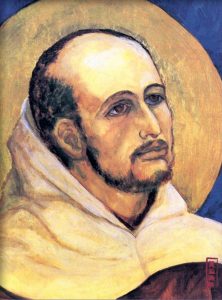
In the blessed night
From Dark Night of the Soul, by St. John of the Cross
In secret that none saw me
Nor I beheld aught
Without any other light or guide
Save that which was burning in the heart
December 21
St. Peter Canisius
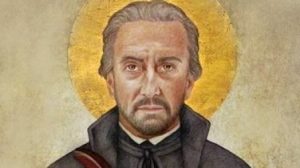
Peter Canisius was educated in Cologne, Germany, studying art, civil law and theology; he earned his master’s degree at the age of 19. After attending a retreat held by Blessed Peter Faber, he joined the Jesuit order in 1543. He taught at the University of Cologne, was appointed bishop of Augsburg, and traveled and worked with his spiritual director, Saint Ignatius of Loyola.
He began teaching theology and preaching in Germany in 1549, and, although he became rector of his university, he continued to work in hospitals and prisons. He led the Counter-Reformation in Germany and his work led to the return of Catholicism to Germany. He wrote a catechism in defense of the Catholic faith that went through 200 editions during his life, and was translated into 12 languages.
Peter excelled as a preacher and often worked with children, teaching them and hearing their confessions. He traveled widely, but while in Switzerland, he received a message from the city’s patron, Saint Nicholas of Myra, that he should stop travelling, and he spent the rest of his life there, teaching, preaching, editing books and working to support the Catholic press. His advice was sought by Saint Francis de Sales, and by his friend Saint Charles Borromeo. He was proclaimed a Doctor of the Church in 1925 by Pope Pius XI.
“Better that only a few Catholics should be left, staunch and sincere in their religion, than that they should, remaining many, desire as it were, to be in collusion with the Church’s enemies and in conformity with the open foes of our faith.”
St. Peter Canisius
December 23
St. John of Canty
Patron saint of Poland and Lithuania, also called John of Kanti or John of Kenty. He was born in Kanti, Poland, and was ordained after studies at the University of Cracow. John was appointed a lecturer on Scriptures and was a popular preacher and parish priest for a few years before returning to his university position. Jealous associates presented a false charge against him and, unable to speak in his own defense, he was stripped of his university position. He was sent in disgrace to a parish in Bohemia as an associate pastor.
Resenting the outsider, the parishioners were hostile the former professor. For years he acted in an exemplary fashion toward his flock. He showed real concern for them and interest in their problems, never allowing himself to become angry or impatient. After eight years, when he was exonerated and allowed to return to the university in Cracow, the parish was genuinely sorrowful to lose their pastor.
For the rest of his life, he served as a professor of scripture in Cracow, well loved by both his students and the residents of the town. Famous for his austerities and care for the poor, he was canonized in 1767 and was declared a patron of Poland and Lithuania by Pope Clement XII (r. 1730-1740) in 1737.
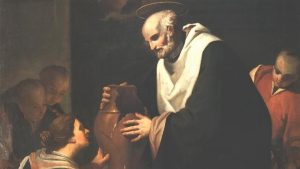
“Fight all error, but do it with good humor, patience, kindness, and love. Harshness will damage your own soul and spoil the best cause.”
St John Kanty
December 26
St. Stephen, Martyr
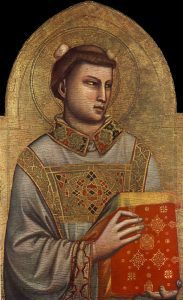
St. Stephen (1st. c.) was one of the Church’s first deacons in Jerusalem and an eloquent preacher of the Gospel of Jesus Christ. According to Sacred Scripture he was “a man full of faith, and of the Holy Ghost” and “full of grace and fortitude.” The account of his martyrdom is recorded in the Acts of the Apostles. After boldly preaching against the Jewish leaders for their rejection of the promised Messiah, he was accused of blasphemy and stoned to death by an angry mob. The man who would later become St. Paul the Apostle, while he was persecuting the Church before his conversion, was among the mob as an approving witness. St. Stephen’s name comes from the Greek word meaning ‘crown,’ fitting as he was the first Christian to earn the martyr’s crown.
Look! I see an opening in the sky, and the Son of Man standing at God’s right hand…Lord Jesus, receive my spirit. Lord, do not hold this sin against them.
St. Stephen
December 28
The Holy Innocents
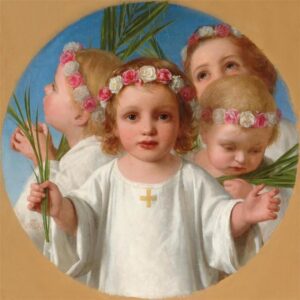
against ambition and jealously
The Holy Innocents (1st c.) are the children mentioned in the account of Jesus’ birth in Matthew’s Gospel (2:16-18). When the Magi came to Jerusalem to find and adore the Baby Jesus, the newborn King of the Jews, King Herod requested that they inform him of the Child’s location under the pretense of offering Him adoration, too. After paying the Child homage and offering Him their gifts, the Wise Men were warned in a dream not to betray Jesus’ location, and departed for their home country by another route. Meanwhile the Holy Family was warned by an Angel to flee into Egypt. King Herod fell into a jealous rage over the Magi’s failure to report back to him. He ordered all the baby boys aged two years and under to be killed, according to the appearance of the Bethlehem Star to the Three Wise Men, in an attempt to kill the Baby Jesus. These baby boys died not only for Christ, but in his stead. The Church venerates them as martyrs. It it is uncertain how many children were killed, whether a small number, or in the thousands. The Latin Church instituted the feast of the Holy Innocents in the fifth century. The Basilica of St. Paul Outside the Walls in Rome is believed to possess the bodies of several of the Holy Innocents. Their feast day is commemorated on December 28th.
In Ramah is heard the sound of sobbing, bitter weeping! Rachel mourns for her children, she refuses to be consoled for her children—they are no more!
Jeremiah 31:15
December 29
St. Thomas Becket
Thomas Becket was both an English military officer and a lawyer who was made the archdeacon of Canterbury in England in 1154. He was a close friend and advisor of King Henry II, spending much time with him and enjoying a lavish lifestyle. At the age of 36 Becket was appointed chancellor of England by the king. Eight years later, Henry supported Becket for the position of the archbishop, despite Becket’s remonstrating that he and the king would soon become enemies, due to Henry’s meddling in church affairs. On that day, Becket renounced his lavish lifestyle and resigned the chancellorship.
Henry began a campaign to diminish the power and independence of the Church in England and to personally persecute Becket, forcing him to flee to France for safety. One tactic of Henry’s was the appointment of bishops who supported his assault on the Church. Becket excommunicated those bishops. After several years, he returned to England, still unwilling to concede the point to the king by lifting those censures. At one point Henry famously cried out in a rage, “Will no one rid me of this troublesome priest!” Four knights, overhearing him, traveled to Canterbury and murdered Thomas before the altar in the Canterbury cathedral in 1170.
